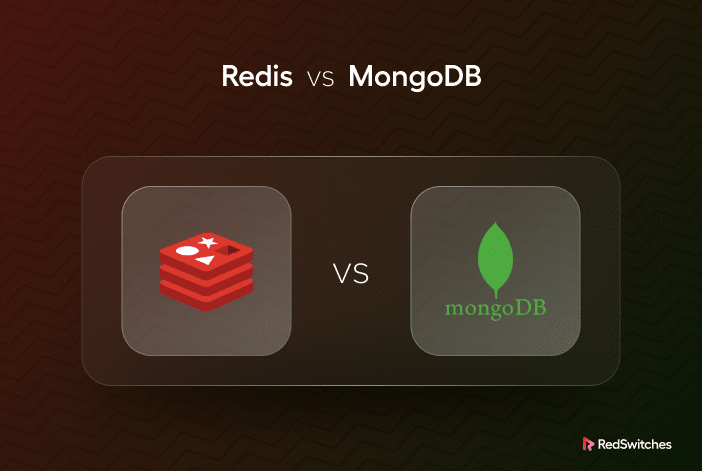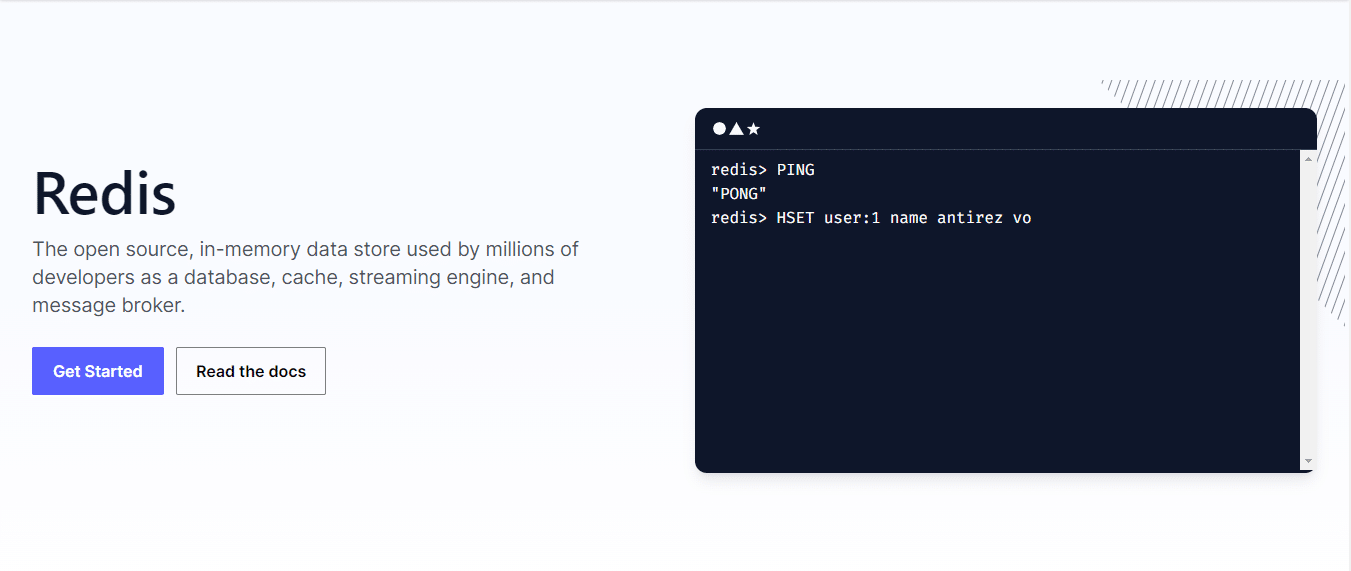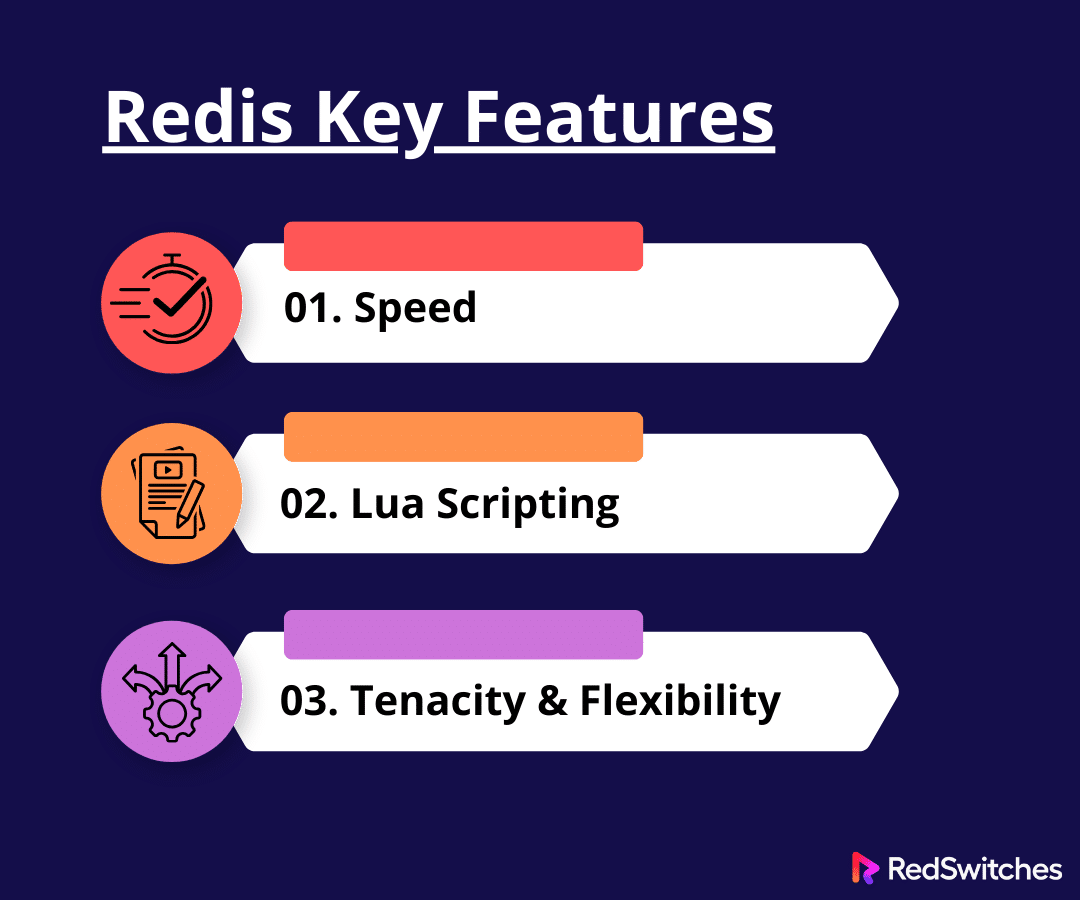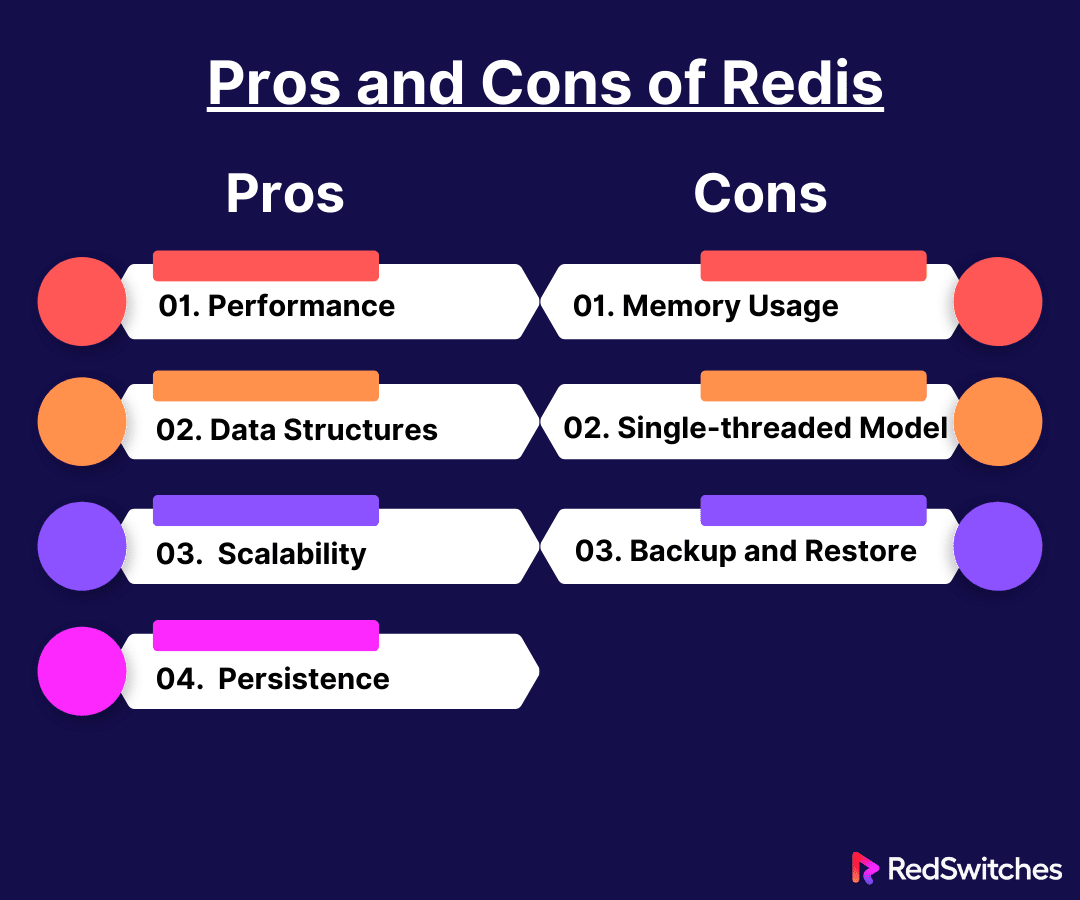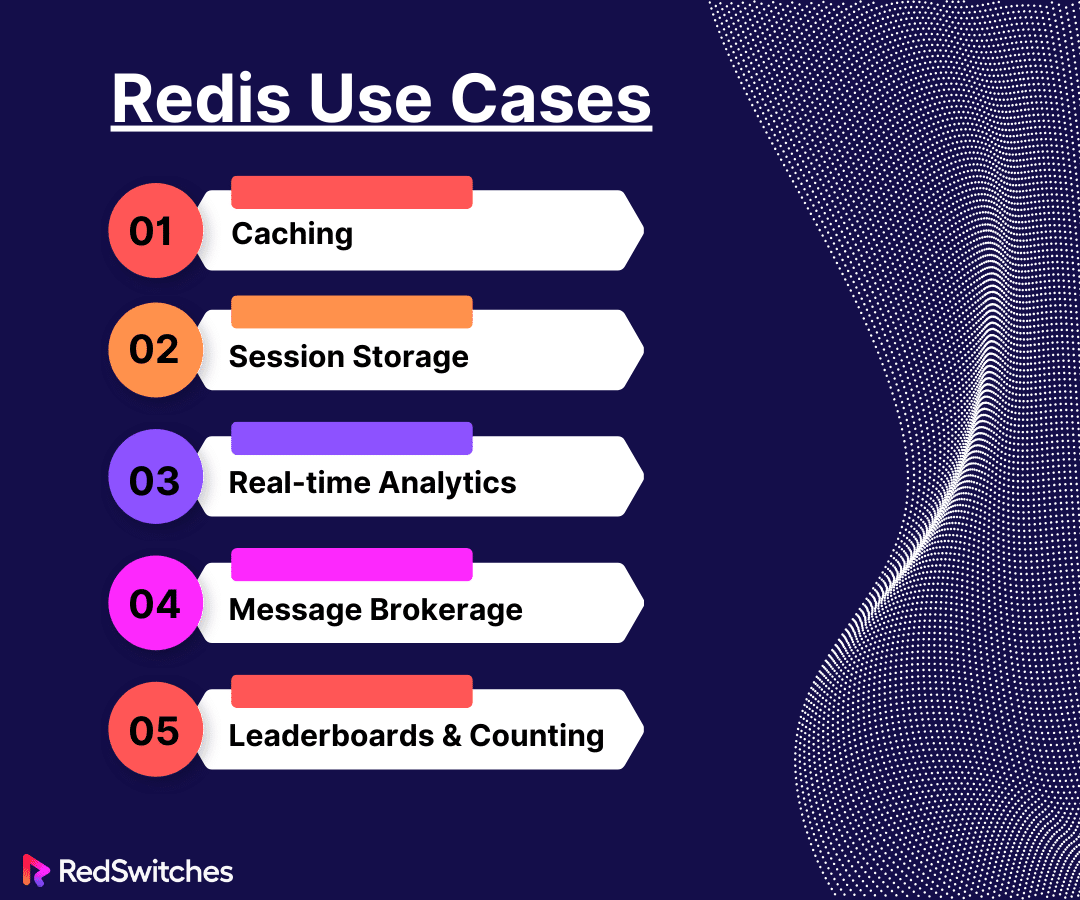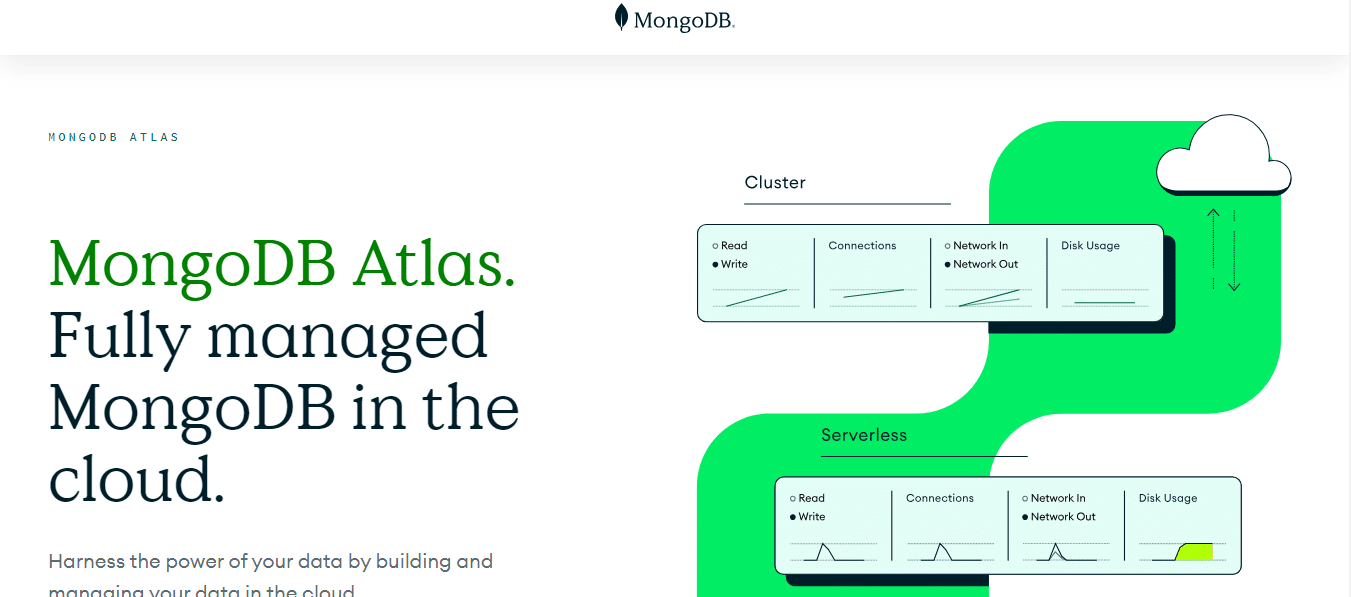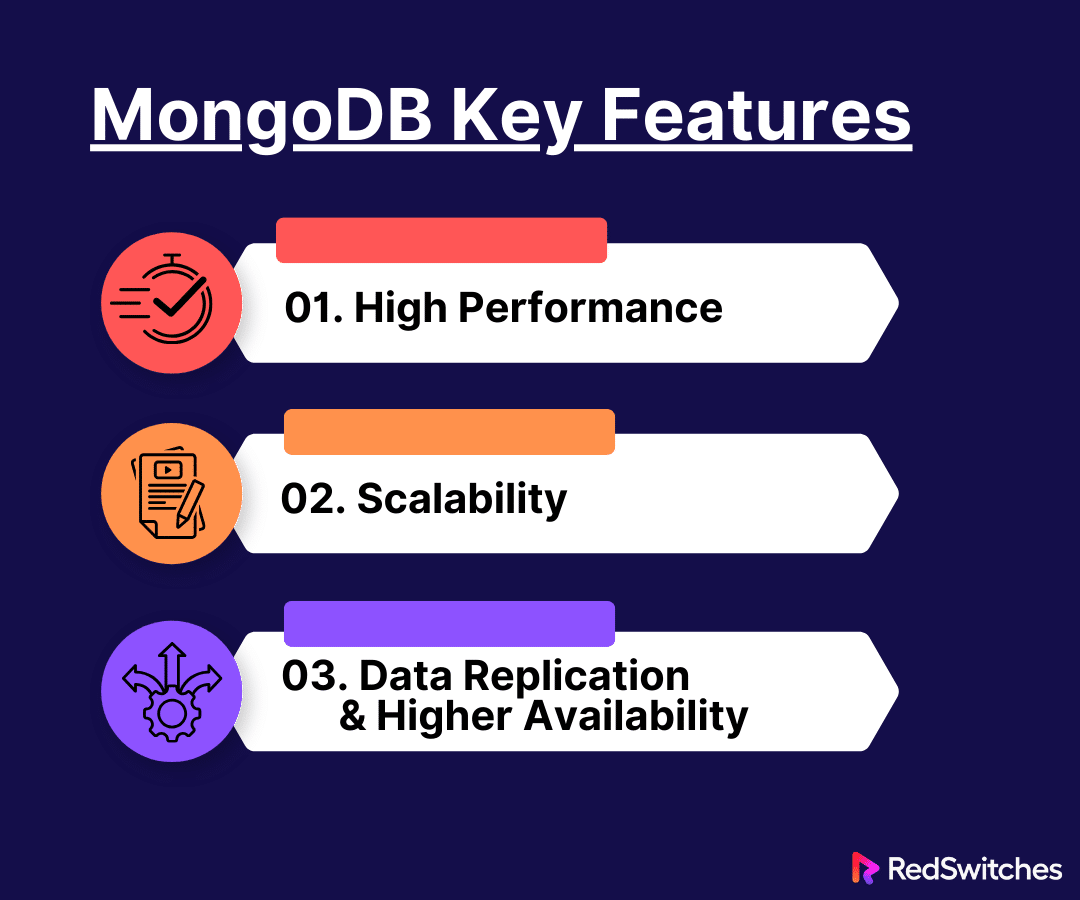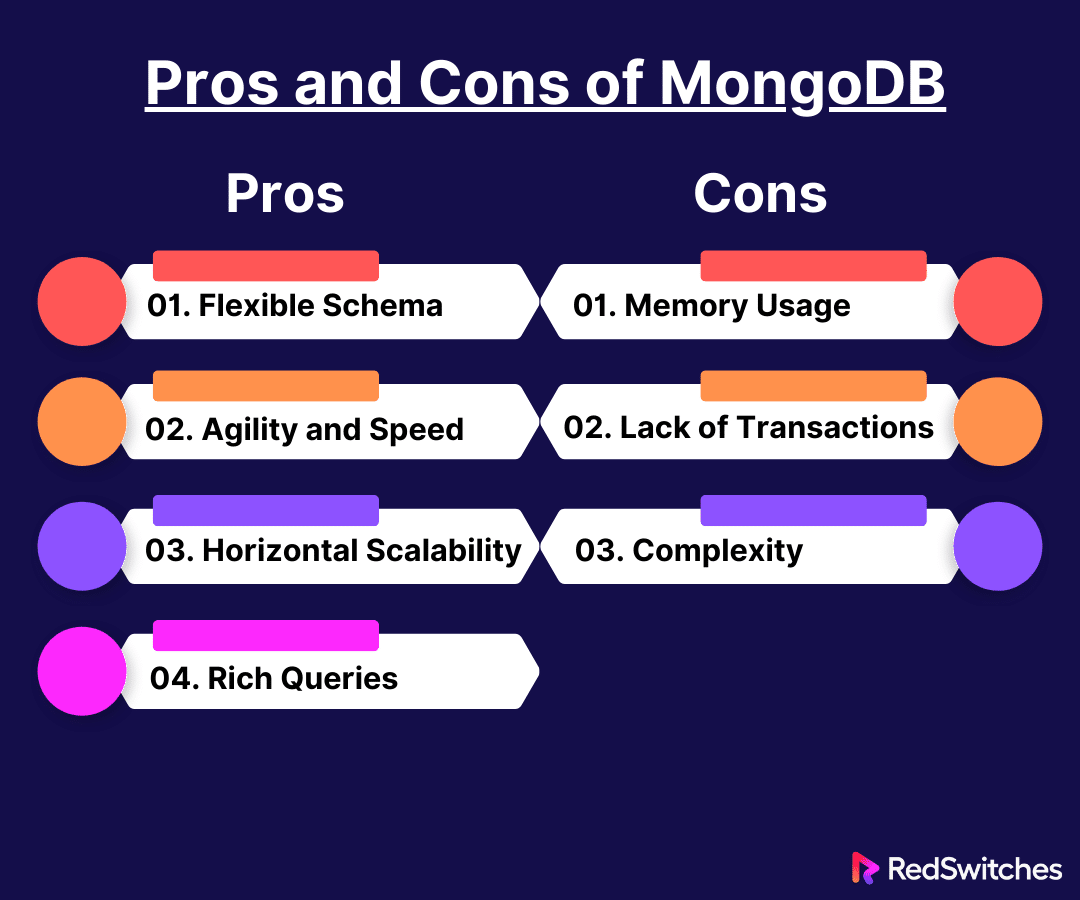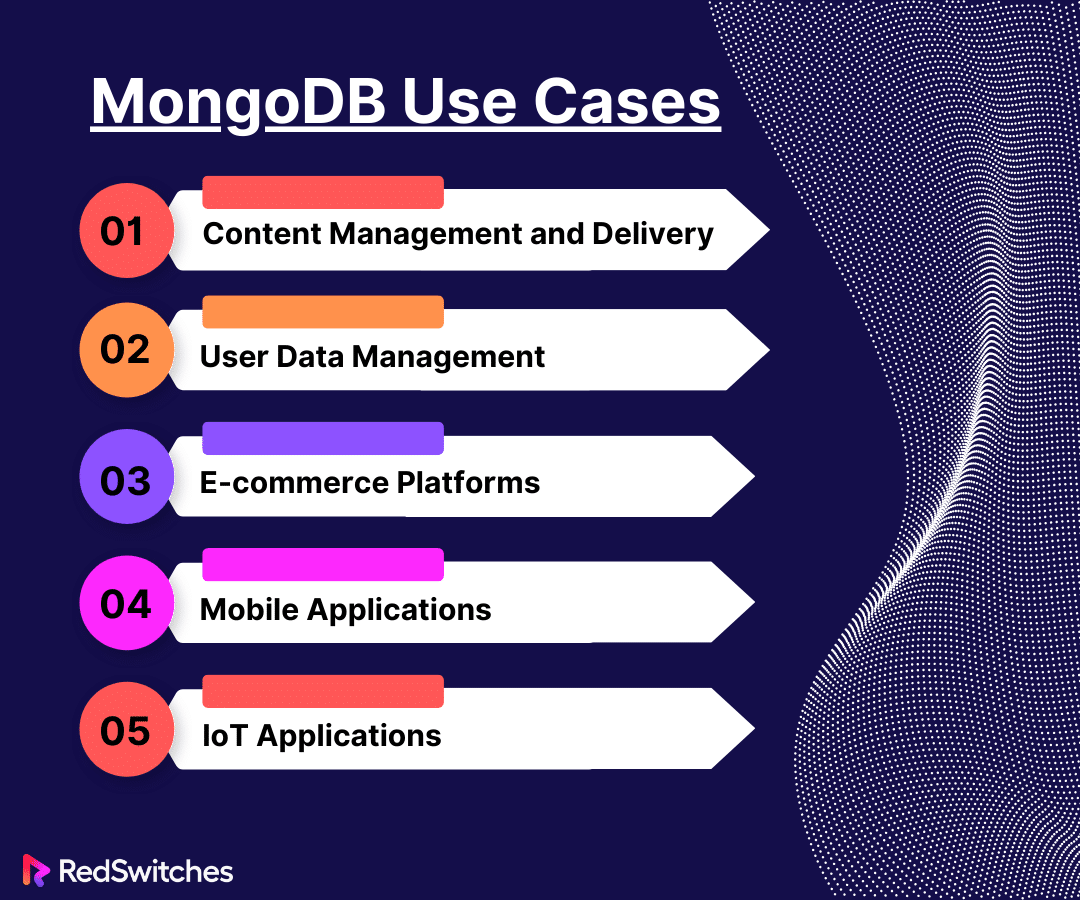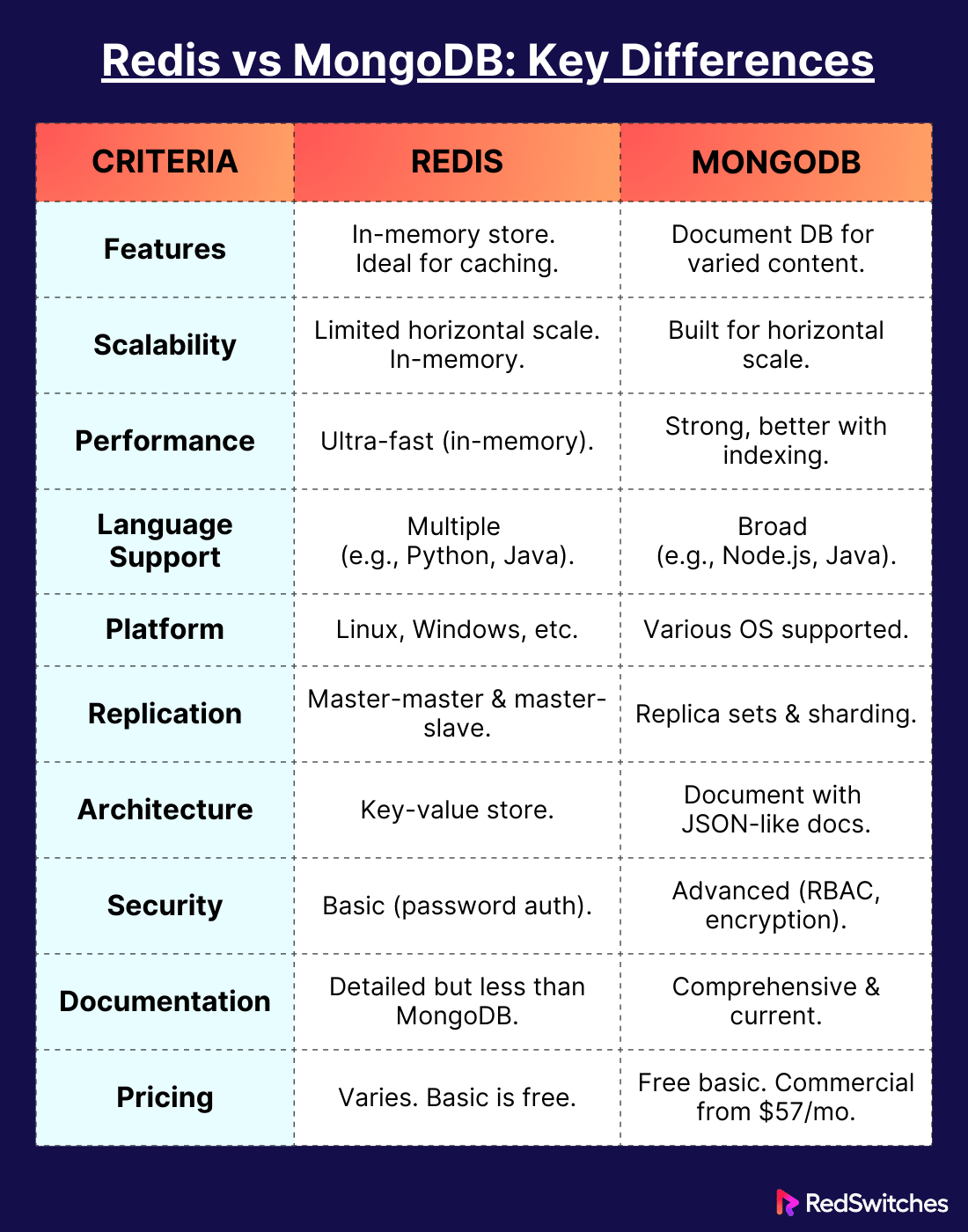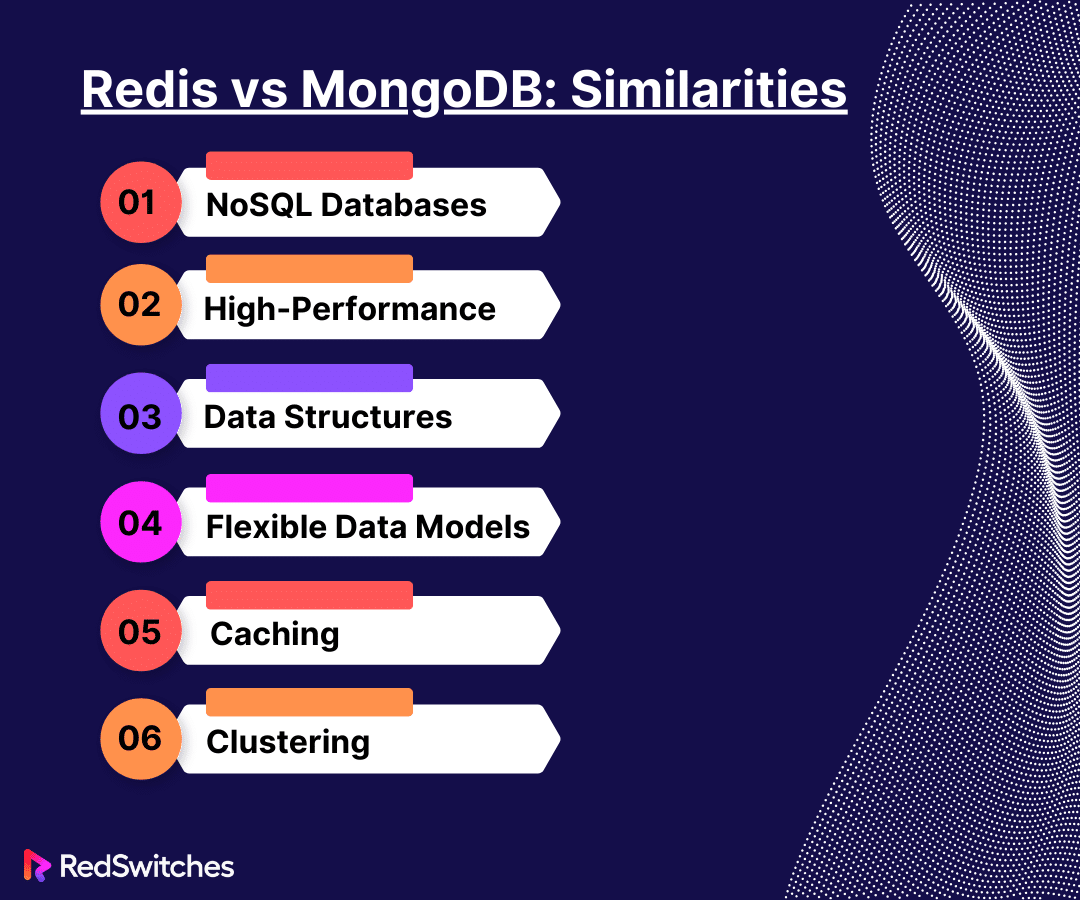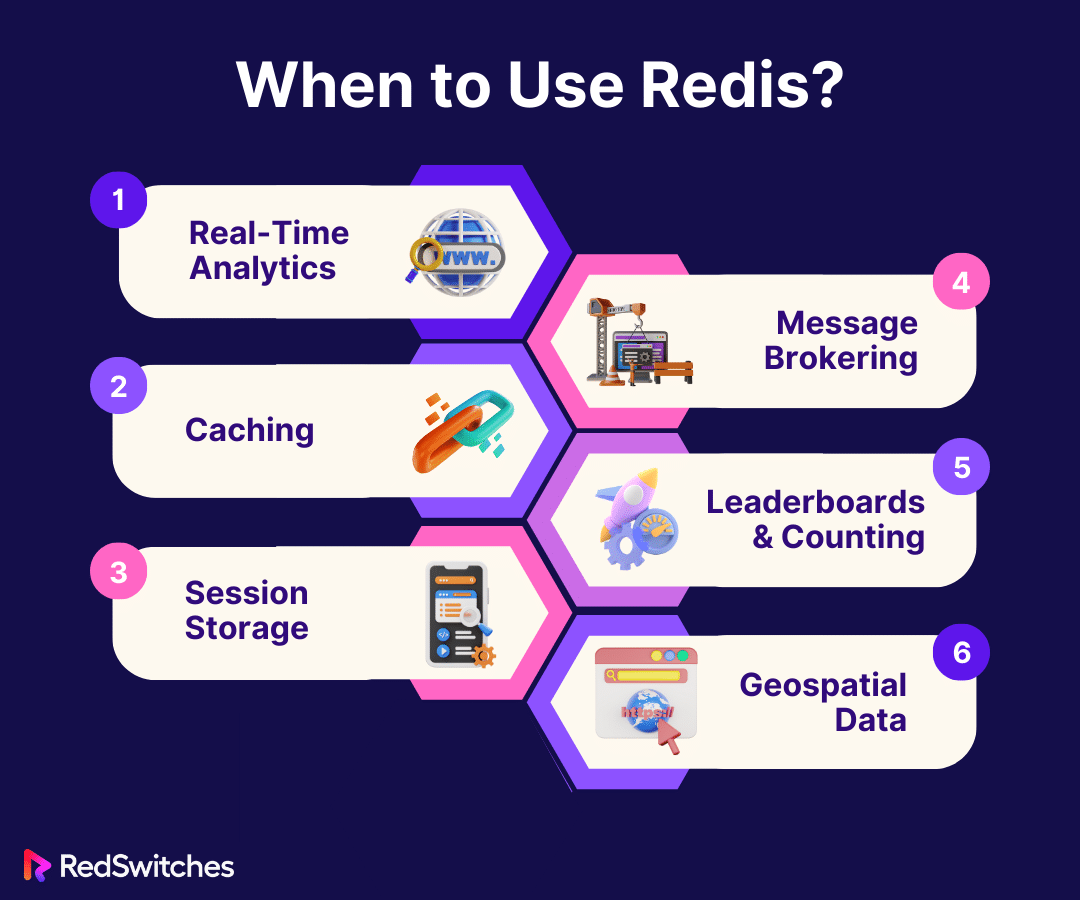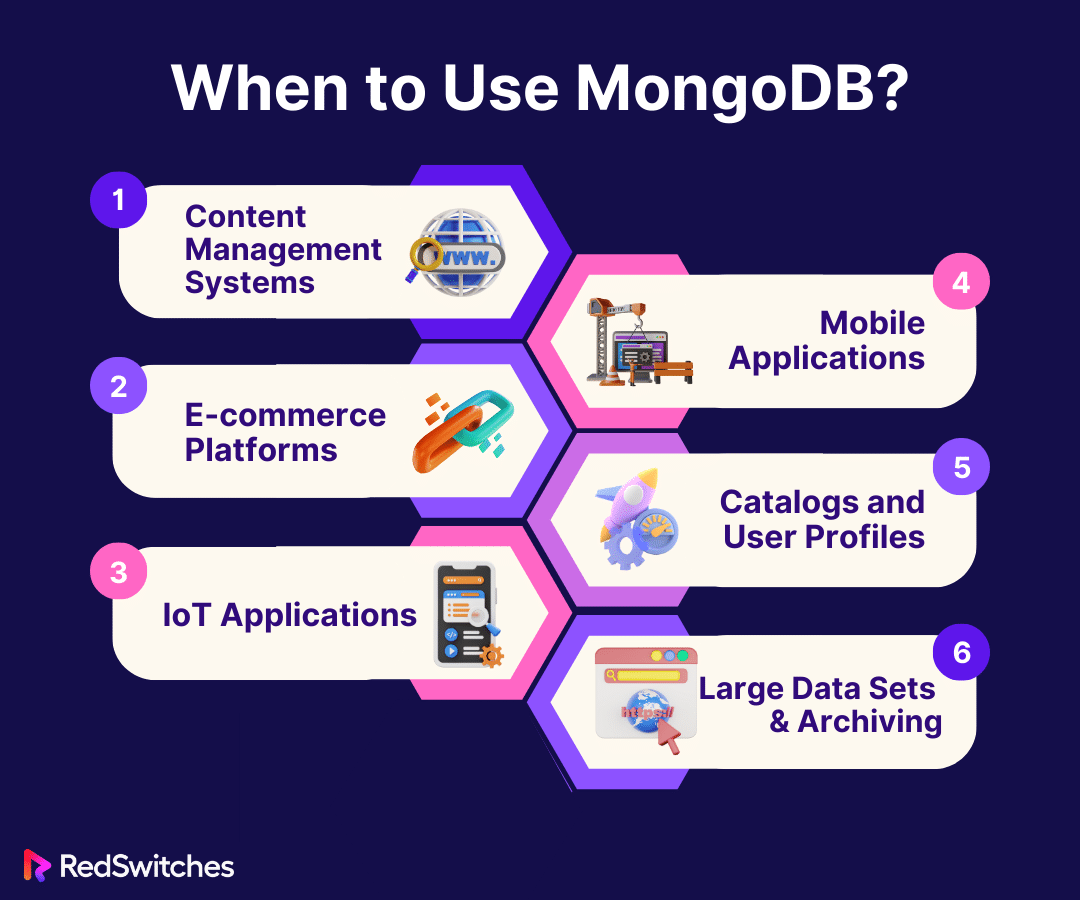As we stride into 2024, the database landscape is transforming profoundly, driven by an insatiable demand for speed, scalability, and flexibility. Standing tall amidst this evolution are two giants of the NoSQL world: MongoDB vs Redis. Both powerhouses, in their own right, have grown, adapted, and evolved to meet the ever-changing needs of the modern digital ecosystem. Yet, as similar as they may seem on the surface, digging deeper reveals a panorama of contrasts.
In this comprehensive analysis, we will dive into the heart of these databases, unraveling the 10 key differences that set them apart and providing insights to choose the perfect NoSQL solution for your enterprise in 2024 and beyond.
Table Of Contents
- What is Redis?
- What is MongoDB?
- MongoDB vs Redis Comparison: What Is The Difference?
- Comparing Redis vs MongoDB: How Are They Similar?
- When to Use Redis?
- When to Use MongoDB?
- Conclusion
- FAQs
What is Redis?
Credit: Redis
Remote Dictionary Server, more commonly known as Redis, is a beacon of high-performance data management in the modern tech ecosystem. An open-source platform, Redis goes beyond the restrictions of conventional databases. Launched in 2009 by Salvatore Sanfilippo, this C-written powerhouse is renowned for its versatile data type support, vast data volume accommodation, and stellar speed.
Redis, at its core, is a key-value data storage system emphasizing an in-memory architecture and single-threaded data processing. Its ascent in popularity is attributed largely to its prowess in rapid data storage, caching, and messaging functionalities.
Dive deeper into the world of NoSQL! Understand the nuances of non-relational databases and arm yourself with the knowledge to make informed choices.
Key Features
Speed:
Touting an unmatched speed, Redis demonstrates its capability by storing vast volumes of data in the main memory in milliseconds. Benchmark figures showcase its impressive ability to perform 110,000 SETs/second and retrieve 81,000 GETs/second, even on a basic Linux box. The swiftness of Redis’s interface further augments its speed, allowing seamless communication with client libraries. This is bolstered by the provision of pipeline commands to optimize task efficiency.
Lua Scripting:
Speed remains a cardinal philosophy for Redis, which is why it leverages the power of Lua Scripting. Recognized as one of the fastest-executing scripts, Lua aids in executing custom scripts without hampering the database’s response time. Its rapid initialization ensures that scripts run swiftly and efficiently.
Tenacity & Flexibility:
Redis is not just about speed but also about versatility. It permits the storage of a myriad of data types in its primary memory. Moreover, it ensures that all asynchronous data modifications, be it updates or changes, are diligently saved to the disk, factoring in the time of the update or the duration elapsed. This feature ensures high availability and incorporates an append-only file persistence mode.
Also Read: How To Install Redis on macOS: 2 Scenarios
Pros and Cons of Redis
Pros:
- Performance: Redis’s in-memory architecture ensures rapid read and write operations, making it one of the fastest data stores available.
- Data Structures: Supports a variety of data structures such as lists, sets, hashes, bitmaps, and more.
- Scalability: Redis can be easily scaled horizontally using partitioning.
- Persistence: Offers a range of options for data persistence, ensuring data durability.
Cons:
- Memory Usage: Being an in-memory datastore, Redis might consume more memory, especially when dealing with large datasets.
- Single-threaded Model: This can sometimes be a limitation for CPU-bound tasks.
- Backup and Restore: This can be slower than other databases due to its in-memory nature.
Redis Use Cases
Redis, known for its high performance and versatility as an in-memory data store, is widely used in various applications. Here are some common use cases for Redis:
- Caching: Owing to its speed, Redis is commonly used as a caching layer to reduce the load on primary databases and improve application performance.
- Session Storage: Due to its rapid access times, web applications frequently employ Redis to store user sessions.
- Real-time Analytics: Redis’s capability to handle high-velocity data makes it apt for real-time analytics applications.
- Message Brokerage: With data structures like Pub/Sub, Redis is proficiently used in messaging systems.
- Leaderboards & Counting: Redis’s sorted sets are handy for online games and platforms that require real-time leaderboards or counting services.
Redis, in conclusion, is more than just a database. It’s a versatile platform that has carved a niche in many applications, from caching to real-time analytics, proving its mettle in the ever-evolving world of data management.
Redis has piqued your interest in in-memory databases, hasn’t it? Uncover the true potential of in-memory databases with real-world examples.
What is MongoDB?
Credit: MongoDB
MongoDB is an avant-garde, open-source NoSQL database that shuns traditional table-based relational databases. Instead, it harnesses the power of BSON—a binary representation of JSON documents. This document-oriented approach implies that data in MongoDB is structured in collections and documents rather than tables and rows.
As a paradigm shift from the constraints of traditional RDBMS, MongoDB offers an alternative adept at handling vast amounts of unstructured data, providing a much-needed respite for developers.
MongoDB’s inception can be traced back to the endeavors of Eliot Horowitz and Dwight Merriman in 2007. Their journey, mired with scalability challenges in web applications with relational databases, culminated in the creation of MongoDB. Today, its robust feature set has made it the go-to choice for countless enterprises.
MongoDB stands out as modern applications grapple with the burgeoning data needs of a globally connected populace. It ensures that data is processed efficiently, ensuring seamless user experiences while keeping server issues at bay.
Key Features
High Performance:
MongoDB takes pride in its performance metrics. Unlike many relational databases, it sidesteps redundant I/O operations. The result? Faster select queries, courtesy of an expedited indexing process.
Scalability:
At the heart of MongoDB’s scalability solution is ‘Sharding.’ This mechanism involves partitioning data across multiple servers, ensuring that vast data volumes are evenly distributed. Even more impressive is MongoDB’s ability to integrate new machines into ongoing databases without a hitch.
Data Replication & Higher Availability:
Data loss and system downtimes are nightmares for any developer. MongoDB turns these fears on its head with its robust data replication feature. By storing data replicas on multiple servers, MongoDB ensures data retrieval despite hardware failures, bolstering system resilience.
Pros and Cons of MongoDB
Pros:
- Flexible Schema: Unlike relational databases, MongoDB’s document-oriented structure allows for diverse data representations.
- Agility and Speed: Its ability to handle large volumes of unstructured data makes it fast and efficient.
- Horizontal Scalability: With sharding, MongoDB scales out by distributing data across many servers.
- Rich Queries: MongoDB supports a rich set of query operations, enhancing data retrieval.
Cons:
- Memory Usage: MongoDB’s extensive memory use can be resource-intensive.
- Lack of Transactions: Unlike RDBMS, MongoDB didn’t initially support multi-document ACID transactions, though this has changed in recent versions.
- Complexity: Mastering MongoDB involves a learning curve for users familiar with SQL.
MongoDB Use Cases
MongoDB, a popular NoSQL database, is renowned for its flexibility, scalability, and diverse applications. Some common use cases for MongoDB include:
- Content Management and Delivery: Its flexible schema design makes storing diverse content types apt.
- User Data Management: Storing profiles, user settings, or other user-centric data is streamlined with MongoDB.
- E-commerce Platforms: MongoDB’s ability to manage catalogs with multiple attributes makes it perfect for e-commerce databases.
- Mobile Applications: The database’s flexibility and scalability make it suitable for real-time data access in mobile apps.
- IoT Applications: With vast amounts of unstructured data from devices, MongoDB becomes an ideal choice.
MongoDB, in essence, embodies the future of databases—agile, scalable, and adept at managing the dynamic data needs of the modern world.
Ready to get hands-on with MongoDB? Follow our step-by-step guide to install MongoDB on Ubuntu seamlessly.
Credit: Freepik
MongoDB vs Redis Comparison: What Is The Difference?
In the professional data management and database technologies sphere, Redis vs MongoDB commands respect and attention. As two of the most prominent NoSQL databases, both offer advanced solutions tailored to modern development needs. Yet, despite their shared category, they cater to different use cases, architectures, and operational nuances.
This section highlights the distinguishing features that separate Redis from MongoDB, presenting an unbiased, in-depth comparison. Whether you’re an enterprise decision-maker, a seasoned developer, or a newcomer to the world of databases, understanding these distinctions is critical. Let’s dissect their core differentiators methodically and comprehensively.
Features
When evaluating the difference between MongoDB and Redis, it’s essential to understand the unique features that each offers. Both Redis vs MongoDB have carved out niches in the NoSQL world, driven by their distinct capabilities and strengths.
Features of Redis:
- In-memory data store: Redis operates primarily in memory, offering lightning-fast data access speeds. However, this also brings the vulnerability of potential data loss in cases like server crashes.
- Key-value store: Data in Redis is stored as key-value pairs. While this design offers quick data retrieval using keys, it’s less flexible for intricate queries.
- Multiple data structures: Redis isn’t limited to just key values; it supports various data structures, such as strings, lists, sets, and hashes. This versatility caters to diverse applications.
- Persistence: Though primarily in memory, Redis provides mechanisms for data persistence, ensuring data longevity. However, this persistence might occasionally impact performance.
- Caching: Redis excels as a caching solution, allowing applications to store and swiftly retrieve frequently accessed data, improving efficiency.
- Message broker: Beyond traditional data storage, Redis can function as a message broker, facilitating communication between different applications.
Features of MongoDB:
- Document database: MongoDB operates as a document database, storing data in JSON-like formats, which facilitates managing and querying complex data structures.
- Schema-less: MongoDB’s design doesn’t mandate a predefined schema. This flexibility is beneficial for evolving data needs.
- Horizontal scaling: With an ability to expand horizontally by integrating more servers into its cluster, MongoDB is aptly equipped for handling high-traffic scenarios.
- Replication: Data replication across multiple servers in MongoDB ensures data availability and resilience.
- Aggregation: MongoDB boasts a robust aggregation framework, empowering users to perform intricate queries and data transformations.
- Geospatial indexing: For applications needing geospatial data management, MongoDB offers specialized geospatial indexing.
Choosing the Right Database:
Redis is the go-to for applications desiring:
- Exceptional performance and low latency
- Real-time data processing capabilities
- Effective caching mechanisms
- Efficient message queuing
MongoDB is ideal for applications that:
- Handle intricate data structures
- Manage high traffic loads
- Require high availability
- Execute advanced queries and data transformations
- Engage with geospatial data
In essence, the decision between Redis DB vs MongoDB should be tailored to the specific demands and objectives of your application.
Scalability
When selecting a database for your application, understanding the scalability of potential options can be pivotal. Scalability refers to a database’s proficiency to accommodate growing amounts of data and handle increased traffic gracefully.
While both Redis vs MongoDB are acknowledged for their scalability, discerning the nuances of their scalability features can guide an informed decision. Let’s dissect the scalability attributes of each and highlight the difference between Redis and MongoDB.
Redis Scalability Features:
- Single-threaded Operation: Redis operates in a single-threaded environment, which implies it processes one request at any time. While efficient for specific use cases, this architecture might present challenges for applications inundated with high read or write demands.
- Horizontal Scaling: Redis can amplify its scaling capabilities horizontally by integrating more servers into its cluster. However, it’s crucial to note that achieving this horizontal expansion entails manual sharding and partitioning data, which can be intricate and prone to errors.
- Moderate Workload Scalability: Despite its limitations, Redis remains competent for applications that don’t experience exceptionally high read or write burdens.
Credit: Freepik
MongoDB Scalability Features:
- Multi-threaded Operation: MongoDB operates in a multi-threaded milieu, capacitating it to process multiple requests concurrently. This inherent advantage propels MongoDB ahead of Redis when tackling applications with substantial read or write workloads.
- Horizontal Scaling & Sharding: Scaling MongoDB horizontally is relatively straightforward, thanks to its built-in support for sharding and partitioning. This not only simplifies the scaling process but also eliminates many potential pitfalls seen in manual approaches.
- High Workload Scalability: MongoDB stands out in scenarios demanding high read or write throughputs given its architecture and features.
Redis DB vs MongoDB: Which to Choose for Scalability?
When scalability is paramount, MongoDB appears to be the more potent contender. Its multi-threaded nature combined with innate support for sharding gives it an edge. However, if your application’s read-and-write demands are moderate and you possess the expertise to manage sharding and partition in Redis, Redis remains a valid contender.
For those aiming to launch applications in any of the aforementioned domains, MongoDB is preferable for the database layer, given its inherent scalability advantages.
Performance
The performance of a database is a primary concern for many applications, and understanding how each database performs under various conditions is crucial. The Redis vs MongoDB performance debate centers around how they store data and manage operations. Let’s delve into the intricacies of their performance capabilities.
Redis Performance Highlights:
- In-memory Data Store: Redis thrives on its ability to store data directly in memory. This grants Redis a tremendous speed advantage, facilitating brisk read and write operations.
- Performance vs. Volatility: With great speed often comes volatility. Given its in-memory nature, Redis is susceptible to data loss during server crashes or restarts.
MongoDB Performance Highlights:
- On-disk Data Storage: MongoDB adopts a document-oriented approach, persisting data on the disk. While this modus operandi contributes to MongoDB’s durability, it can marginally retard its read and write operations compared to in-memory solutions.
- Scalability and Durability: MongoDB’s architecture permits easy horizontal scaling, catering to vast datasets and high traffic. Its on-disk storage design ensures data durability, safeguarding against potential data loss scenarios seen with volatile databases.
Redis vs MongoDB: Choosing for Performance:
If sheer performance, especially concerning read and write speeds, tops your checklist, Redis unmistakably shines. Nevertheless, MongoDB presents itself as an optimal choice for those searching for a blend of durability, scalability, and decent performance.
Credit: Freepik
However, a caveat for aspirants: performance isn’t one-dimensional. The performance metrics for Redis vs MongoDB can oscillate based on specific workloads, configurations, and use-case scenarios. It’s always prudent to conduct comprehensive benchmarks for both databases, tailored to your application’s demands, before cementing your choice.
Programming Language Support
In database systems, the breadth and depth of programming language support can be decisive, especially when integrating various applications. While Redis vs MongoDB offer extensive language support, they cater to developers in distinct ways. Let’s discern their offerings.
Redis Language Support:
Redis provides official drivers and libraries for several mainstream languages, including
- Python
- Ruby
- Node.js
- PHP
- Java
- C#
- Go
MongoDB Language Support:
MongoDB stands out with its comprehensive list of supported languages, some of which include
- Python
- Ruby
- Node.js
- PHP
- Java
- C#
- Go
- C/C++
- Perl
- Rust
- Scala
- Swift
Additionally, MongoDB surpasses with its advanced API offerings:
- Aggregation Framework: Enables intricate queries and data transformations.
- Geospatial Indexing: Aids in querying and understanding geospatial data.
- Change Streams: Facilitates real-time monitoring of data changes.
Redis vs MongoDB: Deciding on Language Support:
Should programming language compatibility be a pivot point, MongoDB emerges as the clear front-runner. It supports a broader palette of languages and furnishes an enriched suite of APIs and libraries.
That said, Redis is by no means a slouch. It caters efficiently to many popular languages, making it straightforward for most common applications.
In essence, if versatility in language support paired with advanced APIs is what you seek, MongoDB is your go-to. However, it remains a potent contender if you’re drawn to Redis for specific use cases or are already accustomed to its environment.
Extend your NoSQL knowledge! From features to advantages, get a holistic view of NoSQL databases and make better data-driven decisions.
Credit: Freepik
Platform Support
In today’s rapidly evolving tech landscape, the ability of a database system to run seamlessly across various platforms is pivotal. Redis vs MongoDB are two prominent players in this domain, each with unique platform compatibility. Here’s a breakdown of their offerings.
Redis Platform Support:
Redis boasts an extensive range of deployment options, including:
- Operating Systems: Linux, macOS, and Windows
- Containerization: Docker and Kubernetes
- Cloud Platforms: AWS, Azure, and GCP
MongoDB Platform Support:
MongoDB, while closely trailing Redis in terms of diversity, offers:
- Operating Systems: Linux and macOS
- Containerization: Docker and Kubernetes
- Cloud Platforms: AWS, Azure, and GCP
- Dedicated Cloud Service: MongoDB Atlas, a tailor-made cloud solution offering a fully managed MongoDB experience.
Redis vs MongoDB: Deciding on Platform Support:
When platform versatility is paramount, Redis has an edge due to its support for Windows. This can be crucial for developers and businesses reliant on Windows infrastructure.
On the flip side, MongoDB brings its proprietary MongoDB Atlas service to the table. For businesses looking for hassle-free, managed MongoDB deployments, Atlas is a boon.
In summation, both Redis vs MongoDB cater admirably to various platforms. Redis shines with its broader OS support, while MongoDB impresses with its dedicated cloud service. Your choice hinges on which platform feature aligns best with your operational needs.
Replication Support
Replication, a foundational aspect of modern databases, ensures data redundancy, high availability, and fault tolerance. Both Redis and MongoDB provide replication mechanisms, yet they adopt distinct approaches. Here’s an in-depth analysis of their replication strategies.
Redis Replication Mechanisms:
- Master-Master Replication: This enables multiple Redis instances to synchronize data bi-directionally, offering flexibility where any server can transition to a master role dynamically.
- Master-Slave Replication: In a more traditional model, one server assumes the master role, handling write requests, while other instances act as slaves, mirroring the master’s data but not catering to direct write operations.
MongoDB Replication Mechanisms:
- Master-Slave Replication: Similar to Redis, MongoDB designates one primary server handling writes, with other servers acting as secondary replicas.
- Replica Sets: An evolved form of replication, replica sets allow MongoDB nodes to replicate data seamlessly, permitting any server to become the primary node as needed.
- Sharded Clusters: MongoDB employs sharded clusters to handle vast datasets and achieve horizontal scalability. Data is apportioned across different shards, with each shard’s data replicated across several servers. This guarantees data availability even amidst server downtimes.
Deciding on Replication Support: Redis vs MongoDB:
When high availability combined with robust horizontal scaling is the objective, MongoDB appears more equipped. The amalgamation of replica sets and sharded clusters makes MongoDB’s replication capabilities more versatile than Redis’s master-master and master-slave paradigm.
Yet, there’s a place for Redis too. If scenarios demand master-master replication or the deployment scenario is a standalone Redis server, Redis remains a competent choice.
Database Architecture
The distinction between Redis and MongoDB lies in their status as NoSQL databases, their underlying architectures, and the applications they are best suited for.
Redis’ Key-Value Store Paradigm:
- Data Structure: Redis functions as a key-value store. Here, keys are represented by strings, while values can encompass varied data structures like strings, hashes, lists, and sets.
- Concurrency: It operates on a single-threaded model, processing one request at any given instance.
- Speed: A significant feature of Redis is its in-memory data storage, which makes it blazingly fast for read-write operations.
MongoDB’s Document Store Paradigm:
- Data Structure: MongoDB thrives as a document-oriented database. Here, data is represented as JSON-like documents, permitting varied complexities, including nested arrays and fields.
- Concurrency: It boasts a multi-threaded model, facilitating concurrent request processing.
- Scalability Features: MongoDB’s forte lies in its robust replication mechanisms and automatic sharding, which equips it to handle large datasets and substantial traffic.
Deciding Between Database Architectures:
The crux is understanding your application requirements.
Opt for Redis when:
- Caching is paramount, ensuring faster access to recurrently used data.
- Real-time Analytics is the objective of analyzing data on the fly, such as in stock trading.
- Session Management for web applications is required.
MongoDB shines in scenarios like
- Content Management Platforms like Drupal and WordPress benefit from the flexible document structure.
- E-commerce Platforms like Magento can handle intricate product catalogs and user behaviors.
- Social Media Platforms MongoDB can comfortably manage the complex data structures and high user volume in platforms like Facebook.
In conclusion, while both Redis vs MongoDB bring individual strengths to the table, understanding the nuances of your application’s needs is crucial. Consulting with database specialists can further illuminate the best path forward.
Security
Both Redis vs MongoDB fall under the NoSQL database category, but their security implementations vary distinctly. Understanding these distinctions is crucial for determining which best aligns with your application’s security needs.
Redis’ Security Mechanisms:
- Authentication: Redis offers password-based authentication and TLS/SSL encryption to safeguard data during transit.
- Authorization: You can set up user and role permissions within Redis.
- Auditing: Redis’s audit logs facilitate monitoring and tracing suspicious activities.
- Sandboxing: This enables you to segregate Redis from other applications, minimizing unauthorized intrusion.
MongoDB’s Security Mechanisms:
- Authentication: MongoDB’s authentication mechanisms are multifaceted, encompassing password-based authentication, role-based access control (RBAC), and integration with LDAP/Active Directory.
- Authorization: A more granular level of permissions can be set in MongoDB, ranging from database and collection to document levels.
- Auditing: Like Redis, MongoDB has audit logs to oversee activities.
- Encryption: A significant edge for MongoDB is its support for at-rest and in-transit encryption.
- Sharding: While boosting performance, sharding in MongoDB can act as an added security layer by making data targeting by attackers more intricate.
Decision Time: Which to Choose for Security?
MongoDB emerges as a front-runner for applications mandating stringent security, courtesy of its RBAC, encryption, and sharding capabilities. Conversely, Redis, with its introductory security provisions, might be apt for projects prioritizing performance yet requiring foundational security.
Applications demanding paramount security include:
- Financial services: Where safeguarding user financial information is non-negotiable.
- Healthcare: Patient data protection is both ethically and legally mandated.
- Government: Any compromise of sensitive information can have nationwide implications.
For projects in these sectors, MongoDB is advisable.
Documentation Support
Redis vs MongoDB are leading NoSQL databases with extensive documentation to aid developers. However, nuances in their documentation can influence the choice between them, especially when considering developer support and ease of learning.
MongoDB’s Documentation Highlights:
- Getting Started Guides: Facilitates newcomers with step-by-step instructions for installation, configuration, and primary usage.
- Reference Manuals: Delve deep into MongoDB aspects, from database schema to APIs.
- Tutorials: Practical lessons demonstrating typical MongoDB tasks and features.
- API Documentation: Exhaustive details on MongoDB’s APIs catering to multiple programming languages like Java, Python, and Node.js.
- Troubleshooting Guides: Aid in diagnosing and resolving frequent MongoDB hitches.
Redis’ Documentation Highlights:
- Tutorials: Practical demonstrations of fundamental Redis tasks, from key-value pair operations to working with diverse data structures.
- Command Reference: In-depth insights into all Redis commands.
- Configuration Guide: Guidance on tailoring Redis settings.
- FAQ: Addresses recurring questions and clarifications about Redis.
Decision Time: Which to Choose Based on Documentation?
If robust documentation support holds significance for your project:
- MongoDB stands as the favorable choice given its expansive, up-to-date, and detailed documentation. This can be instrumental for large-scale enterprise applications where multiple developers might need frequent reference materials or for open-source ventures where contributors from the community would appreciate extensive resources.
- Redis, on the other hand, shouldn’t be dismissed. Its concise and straightforward documentation can be a boon for projects prioritizing simplicity and swift ramp-up times.
Applications emphasizing education, where documentation clarity and structure are paramount, would benefit from MongoDB’s detailed approach.
Pricing
Both Redis vs MongoDB provide cloud-based solutions with varying cost structures, catering to the different needs of organizations and individuals.
Redis Enterprise Cloud Pricing:
Basic Plan:
- Cost: Free.
- Typically aimed at smaller projects and hobbyists. It’s a great option for individuals or startups with limited resources who want to familiarize themselves with Redis without financial commitment.
Advanced Plans:
- Starting Cost: $7/month.
- Offers additional features, scalability options, and support over the Basic plan. This suits businesses or larger projects that need enhanced capabilities and reliability.
MongoDB Cloud Pricing:
Basic Plan:
- Cost: Free.
- Similar to Redis’ basic plan, MongoDB’s free tier (MongoDB Atlas Free Tier) targets those wanting to explore MongoDB’s features or for smaller projects with minimal requirements.
Commercial License:
- Starting Cost: $57/month.
- Aimed at businesses and larger applications that demand more from their database solutions. Provides advanced features, better support, and scalability options.
Which to Choose Based on Pricing:
- Budget Constraints: If budget is a primary concern and you’re looking for the most cost-effective solution, starting with the free tiers of both platforms can be a viable option. However, as your project grows, the costs will inevitably increase as you move to higher-tier plans.
- Future Scaling: Consider the future scaling needs of your project. While initial costs might be low, pricing models might differ significantly between the two platforms as you scale up. Investigate the long-term costs associated with each.
- Features vs. Cost: Sometimes, it’s not just about the cost but the value derived from it. Even if MongoDB’s commercial license starts at a higher price than Redis’s advanced versions, it might offer features or benefits that Redis doesn’t (and vice versa). Weigh the features you’re getting for the price.
Lastly, it’s worth noting that both platforms’ costs might change over time based on competitive pressures, changes in their offerings, or other market dynamics. Always check the official websites or contact providers for the most current pricing information.
Comparing MongoDB vs Redis: How Are They Similar?
While Redis vs MongoDB are recognized as leading NoSQL databases, each with its unique architecture and set of features, they also share several similarities in their design and function. Both databases result from the technological shift towards scalable, non-relational databases that can handle vast amounts of unstructured data.
As we delve into this section, we will uncover the common ground between Redis vs MongoDB, highlighting how these similarities could influence the choice of database for specific applications.
NoSQL Databases
Both Redis vs MongoDB herald from the NoSQL family, departing from traditional relational databases.
- Neither database utilizes the traditional relational database structure.
- This allows both to efficiently manage vast volumes of unstructured or semi-structured data.
- Being NoSQL databases, Redis and MongoDB are equipped to address modern application needs, emphasizing scalability and adaptability.
High-Performance
High-speed performance is a shared hallmark between Redis vs MongoDB, making them both sought after for real-time applications.
- Redis ensures lightning-fast data retrievals with its in-memory data store capabilities.
- MongoDB, with its robust indexing, guarantees efficient pull of data from disk storage.
- When evaluating Redis vs MongoDB in performance metrics, both promise high throughput and low latency.
Data Structures
Though Redis is a key-value store and MongoDB is document-oriented, they both support versatile data structures.
- Redis accommodates structures like strings, lists, sets, and hashes.
- MongoDB can house diverse data sets, including embedded arrays, documents, etc.
- Their versatility in data storage solutions speaks to their adaptability in catering to diverse application needs.
Flexible Data Models
Flexibility in data modeling is a shared strength, allowing developers to tailor data storage according to evolving requirements.
- Redis’s key-value model is a testament to simplicity, offering flexibility without unnecessary complexity.
- MongoDB’s BSON format, on the other hand, is not just about documents—it supports rich data structures and hierarchies.
- Their malleable data models mean both databases can pivot quickly as application needs change, offering longevity in design choices.
Caching
Caching capabilities are intrinsic to both Redis vs MongoDB, enhancing performance and ensuring efficient data retrieval.
- Redis is often employed as a caching layer, given its in-memory storage prowess.
- MongoDB, with its WiredTiger storage engine, employs internal caching mechanisms to optimize read-heavy operations.
- The inherent caching abilities in both databases, when considering Redis vs MongoDB, underscore their commitment to delivering data promptly.
Clustering
Both Redis vs MongoDB emphasize the significance of clustering for scalability and high availability.
- Redis supports clustering, enabling partitioning of data across multiple Redis nodes.
- MongoDB’s sharding facilitates horizontal scaling, distributing data across multiple servers.
- Clustering capabilities in both databases attest to their design focus on ensuring data availability, even under heavy loads.
When to Use Redis?
Redis, an open-source in-memory data structure store, serves a multitude of use cases. While its functionality is diverse, some scenarios stand out where Redis proves to be especially advantageous:
Real-Time Analytics
- Rapid Data Access: Given its in-memory nature, Redis is adept at delivering data at exceptional speeds, which is crucial for real-time analytics.
- Streaming: Redis Streams allow efficient handling of streaming data, making it suitable for applications that require constant data feeds.
Caching
- Speed Enhancement: Redis is a popular choice for caching, reducing the need to access primary databases or compute systems frequently, thereby increasing application speed.
- Data Persistence: Though primarily in-memory, Redis offers data persistence options, ensuring that cache data isn’t entirely volatile.
Session Storage
- Fast Session Retrieval: For web applications, Redis ensures quick session data retrieval to provide seamless user experiences.
- Scalability: Redis can scale to handle increasing session data volumes without sacrificing performance as user bases grow.
Message Brokering
- Pub/Sub Model: Redis’s publish/subscribe model is apt for applications requiring message brokering capabilities, ensuring timely message deliveries.
- Reliability: Its queue mechanisms can ensure messages are processed even during high traffic, preventing data loss.
Leaderboards & Counting
- Sorted Sets: Redis’s data structures, especially Sorted Sets, efficiently maintain leaderboards for gaming or other competitive platforms.
- Incremental Count: It allows for real-time updating, making it suitable for applications that need to maintain and display real-time counts like social media likes or shares.
Geospatial Data
- Geospatial Commands: Redis’s support for geospatial commands like radius search makes it ideal for location-based services such as ridesharing apps or location-based promotions.
In essence, Redis excels in scenarios that require rapid data access, scalability, and flexibility. Whether you’re developing a real-time analytics dashboard, a high-performance e-commerce site, or a popular multiplayer game, Redis’s capabilities can significantly bolster your application’s performance and responsiveness.
Curious about the other side of the coin? Understand the foundation of relational databases and see how they compare.
When to Use MongoDB?
MongoDB, a leading NoSQL document database, offers a dynamic schema with varied data structures, making it a top choice for diverse applications. While MongoDB’s versatility is broad, there are some scenarios where its features mainly shine:
Content Management Systems (CMS)
- Dynamic Schema: MongoDB’s flexible schema allows for varied content types, making it easier to manage diverse content without altering the underlying database structure.
- Hierarchical Data: Storing content hierarchies or taxonomies is straightforward with MongoDB’s nested documents and arrays.
E-commerce Platforms
- Catalog Management: MongoDB’s flexible document model can handle the varied and changing nature of product attributes efficiently.
- Scalability: As e-commerce platforms grow, MongoDB can scale horizontally to handle increased traffic and data.
IoT Applications
- Time-Series Data: MongoDB can store time-stamped data from multiple devices efficiently.
- Geospatial Data: For applications that require location tracking, MongoDB offers geospatial features suitable for IoT functionalities.
Mobile Applications
- Data Variety: Mobile apps often evolve rapidly. MongoDB’s schema-less nature can accommodate changes without major database redesigns.
- Real-time Sync: MongoDB supports real-time data synchronization between servers and devices, enhancing user experiences.
Catalogs and User Profiles
- Diverse Attributes: Whether it’s user profiles with varied data or product catalogs with diverse attributes, MongoDB’s flexible data model is apt.
- Personalization: The ability to store and query diverse user attributes aids in tailoring personalized experiences.
Large Data Sets & Archiving
- Horizontal Scalability: MongoDB’s sharding capabilities ensure smooth performance, even with vast amounts of data.
- Data Lifecycle Management: Built-in tools for data aging and tiered storage make MongoDB a viable solution for archiving.
MongoDB is the go-to database for scenarios requiring flexibility, scalability, and varied data storage. Whether building a modern CMS, a bustling e-commerce site, or a data-intensive IoT system, MongoDB’s rich feature set can seamlessly cater to evolving application needs.
Conclusion
Choosing between Redis and MongoDB can be a significant decision, depending on your application’s specific requirements. Both these databases have unique strengths and weaknesses. Still, when considering the nuances of “Redis vs MongoDB,” it’s essential to evaluate them based on their specific features and what you need for your project.
In navigating the intricate landscape of database selection, RedSwitches emerges as a pivotal ally. Beyond mere server solutions, RedSwitches offers expert consultation, performance optimization, and tailored infrastructure solutions to align with your chosen database.
Whether it’s the high-performance caching of Redis or MongoDB’s diverse content structures, RedSwitches ensures peak performance, security, and sustained support. Embark on your database journey with the insights and expertise of RedSwitches.
FAQs
Q. Which is the fastest in-memory database?
Redis is often regarded as the fastest in-memory database due to its efficient key-value storage mechanism and single-threaded nature.
Q. How is Redis faster than DB?
Redis is faster than traditional databases because it operates in-memory, eliminating the need to access the disk, leading to rapid data access and manipulation.
Q. Should you use Redis as a database?
Yes, Redis can be used as a database, especially for cases requiring rapid access like caching, session management, and real-time analytics. However, it’s essential to consider data persistence needs and backup strategies, given Redis’s in-memory nature.
Q. What is the difference between MongoDB and Redis?
MongoDB is a popular document-based, NoSQL database, while Redis is an in-memory key-value store often used for caching and real-time data processing.
Q. When should I use MongoDB instead of Redis?
MongoDB is suitable for storing large volumes of diverse, structured, and unstructured data, while Redis is better for caching, session storage, and real-time analytics.
Q. Can I use MongoDB and Redis together in a project?
Yes, it’s common to use both databases in a single project. MongoDB can handle the persistent storage of data, while Redis can serve as a fast, in-memory cache.
Q. Which database is faster, MongoDB or Redis?
Redis is generally faster than MongoDB due to its in-memory nature, but the performance comparison may vary based on specific use cases and workload.
Q. What are some advantages of using MongoDB over Redis?
MongoDB offers flexible data models, strong query language support, and the ability to store large amounts of data on disk, making it suitable for a wide range of applications.
Q. In what scenarios is Redis better suited than MongoDB?
Redis is excellent for real-time data processing, cache management, and scenarios that require extremely low-latency data access due to its in-memory storage and support for various data structures.
Q. Can Redis be used for complex data storage and querying like MongoDB?
While Redis is powerful for certain use cases, it’s not as feature-rich as MongoDB in terms of complex querying, data manipulation, and support for diverse data types.
Q. How does the data storage mechanism differ between MongoDB and Redis?
MongoDB stores data on disk by default, offering persistence and durability, while Redis primarily stores data in-memory, providing exceptionally fast read and write operations.
Q. What are some key factors to consider when comparing MongoDB and Redis for a project?
Consider factors such as data volume, query performance, data structure complexity, real-time processing needs, and the balance between persistence and in-memory operations when comparing MongoDB and Redis.
Q. Can I switch from using MongoDB to Redis or vice versa in an existing project?
It’s possible to transition from one database to the other, but careful consideration of the specific data storage and retrieval requirements, along with potential performance implications, is crucial when making such a shift.
